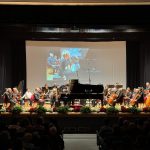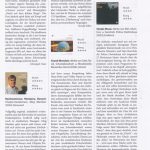Classical Source, July 2014
Felix Mendelssohn—Complete Works for Piano & Orchestra South Jutland Symphony Orchestra / Cond. David Porcelijn Danacord DACOCD 734-736
Reviewed by Antony Hodgson, Classical Source
This is a fine showcase for Felix Mendelssohn’s remarkable contribution to the piano repertoire.
Judging on the more-often-performed of his works for piano and orchestra (sadly, very few come into that category) listeners might be persuaded that the composer’s concerto style has similarities to that of the generation-younger Brahms. Certainly the furious opening of Concerto No.1 is similar in mood to the fiery beginning of Brahms’s D minor Piano Concerto, but really Mendelssohn’s inspiration in this field probably remains with Beethoven. The Romantic era has begun; where earlier composers wrote firm chords, arpeggios and even the famous Alberti bass, Mendelssohn, in fast movements, gives the pianist myriads of notes in the left-hand, running eagerly forward. They provide similar harmonies to those presented by earlier composers but they supply a cushion for the melodies in an individual way. Later, some creators of the Romantic era took on a similar style, it can sometimes be heard in Saint-Saëns, but Mendelssohn was one of the earliest to exploit this element.
Oleg Marshev’s exposition of the left-hand writing is flawless and the underpinning of melodies, especially in forceful moments, is immaculate. The vivid Concerto No.1 immediately indicates how the potent side of Mendelssohn is to be presented. The balance relationship between piano and orchestra is nicely judged, the sound is big within a spacious-sounding hall, the orchestra (not particularly large, judging by the booklet illustration) is exceptionally full-bodied. I was particularly impressed with the woodwind, which affords the Dvořák-like subsidiary section of the first movement a particular charm. After the touching sentimentality of the slow movement we are hurled into the fastest of readings of the finale that I have encountered. Fine if the pianist can play all the notes; Marshev most certainly can!
The Serenade and Allegro Giocoso makes a substantial (12½-minute) interlude. The former in quasi-variation form is soulful, the Giocoso section is sadly jolly (the key is B minor after all) and is cheered up by some riotous orchestral intercessions. Pianistic virtuosity is the essence of the piece. Piano Concerto No.2 is perhaps the most serious work in this collection; the minor key (and all the solo-piano concertos are in the minor) is used for thoughtful exposition of ideas. There is an element of virtuosity of course, but the gentler themes have the type of peacefulness encountered in Chopin and the Adagio is one of Mendelssohn’s most serenely romantic.
Two more single-movement works end the generously-filled Disc 1. The rollicking Rondo Brilliant starts with hunting calls and has an equestrian rhythm throughout. The orchestra bounces rhythmically; the piano presents cheerful melodies with sparkling octave runs in all directions. Capriccio Brilliant begins with a slow introduction before Mendelssohn has the pianist rushing off in spectacular style again. The sound of the orchestral accompaniment is less detailed than in the concertos but I feel that this is much to do with Mendelssohn’s firm supportive chording.
Disc 2 explores the unfamiliar. I observe commentators praising the skill of the 13-year-old Mendelssohn’s Concerto for Piano and String Orchestra, yet it is not often heard. Classically inspired and commencing with a symphonic exposition it differs from the later works in that it is very discursive. The pianist chooses to linger at each return of the main theme, achieving a romantic effect but I am not certain that the melody has the strength to warrant it. In Concertos 1 and 2 Mendelssohn says a great deal in around 20 minutes but writing in the previous decade the teenager prefers to provide an array of challenging melodies – snatches of which could almost be by Beethoven, others perhaps by Sir Arthur Sullivan, now and again there are hints of Weber. The material may not fully justify the 35-minute length and the tuneful slow movement is somewhat naïve but the cool and simple finale has great charm and I like the wrong-footed rhythmic ending to the first tune. The virtuosic display found in the later Concertos is slightly hinted at. Fine sound from the strings which are recorded with immediacy.
The unfinished Concerto known recently as No.3 is intriguing. Since the piano part of the first two movements was completed by Mendelssohn it is valuable evidence of his style in the mid-1840s, but there is scarcely any orchestration. I have seen copies of the manuscript of the first few pages and apart from the very beginning, the lack of indication as to what instruments are accompanying is disappointing. At least we know that the piano enters early on but the rest is up to the skill of Marcello Bufalini who has done a fine job of reconstruction. There is one unconvincing passage where a long melody is led by flute and does not seem at all in keeping but the lead to the coda is convincingly Mendelssohnian with only some chugging bass accompaniments near the end seeming unstylish, yet in the context they are an essential addition. The melodious slow movement might well have been composed by Mendelssohn like this however. It is well possible to enjoy the work by letting this easy-listening piece run happily forward without concentrating too hard. Marshev plays clearly and skilfully, not over-shaping or caressing any tunes, they are too straightforward for that, but Mendelssohn’s melodic invention is always worth hearing despite the complex problems of its presentation. There remains the finale and it is admirably in style. I have no idea what evidence Bufalini had for these melodies, very little I suspect, for the themes seem embarrassingly simple but Bufalini makes the treatment of them convincingly like Mendelssohn.
On Disc 3 the two Concertos for Two Pianos may have been composed mainly as entertainment music, and major-keys are used, yet they are very substantial and the opening of the A flat Concerto is expansively dramatic. At around 40 minutes it is a large-scale work but it does not outstay its welcome. Indeed its construction is in no less taut than the shorter Concertos. The use of two pianos is exciting but there is serious intent and Mendelssohn does not merely set out to exploit virtuosity – this element grows naturally from the content of the music. The gentle companionship of the instruments is particularly delightful in the slow movement and in the finale the interplay is of jollity. Years ago it was fashionable for critics to assess the nature of “stereo spread” and here the engineering has got it entirely right. The E major work has the two soloists reversing their roles with Anne Mette Stæhr taking the Primo part. Again we have an extensive work and after a quiet opening the soloists tend to respond to the orchestral statements rather than initiate them. There is perhaps a little more of the ‘entertainment’ aspect in the writing here. Gentle optimism is evident but by the time the finale is reached gentle gaiety seems an appropriate description.
Disc 4 is described as a “bonus” (DACOCD 736B), perhaps to justify the shorter playing time but this is no problem for the Concerto for Violin and Piano is a sizeable piece. There are a few moments where the soloists are permitted to exploit their virtuosity and at first the writing for violin is reminiscent of Paganini when in calmer mood. I like the positive way in which it is presented by Rumen Lukanov. The piano’s weight of tone is nicely matched – excellent engineering – the forward placement of the soloists is perfectly acceptable here (they are accompanied only by strings). Incidentally the admirably rich-toned piano has a slightly dry character in the highest reaches and this is more obvious in this work than elsewhere but this is not a complaint since it is an aid to hearing detail. Once again the music becomes livelier on reaching the finale – Mendelssohn has this gift for writing in the minor-key and yet achieving a feeling of glee.
Apart from Marshev, known for his many recordings for Danacord, the other artists are not too familiar (I suspect), but here is great artistry and the South Denmark Philharmonic Orchestra (Sønderjyllands Symfoniorkester) has an attractively rich sound, enhanced by a warm acoustic. I foresee much success for this release – its front cover is an unfinished water colour by Mendelssohn, from Interlaken, painted in his final year – to match the previous release of Chopin’s music for Piano and Orchestra with Marshev and this orchestra and conductor.


